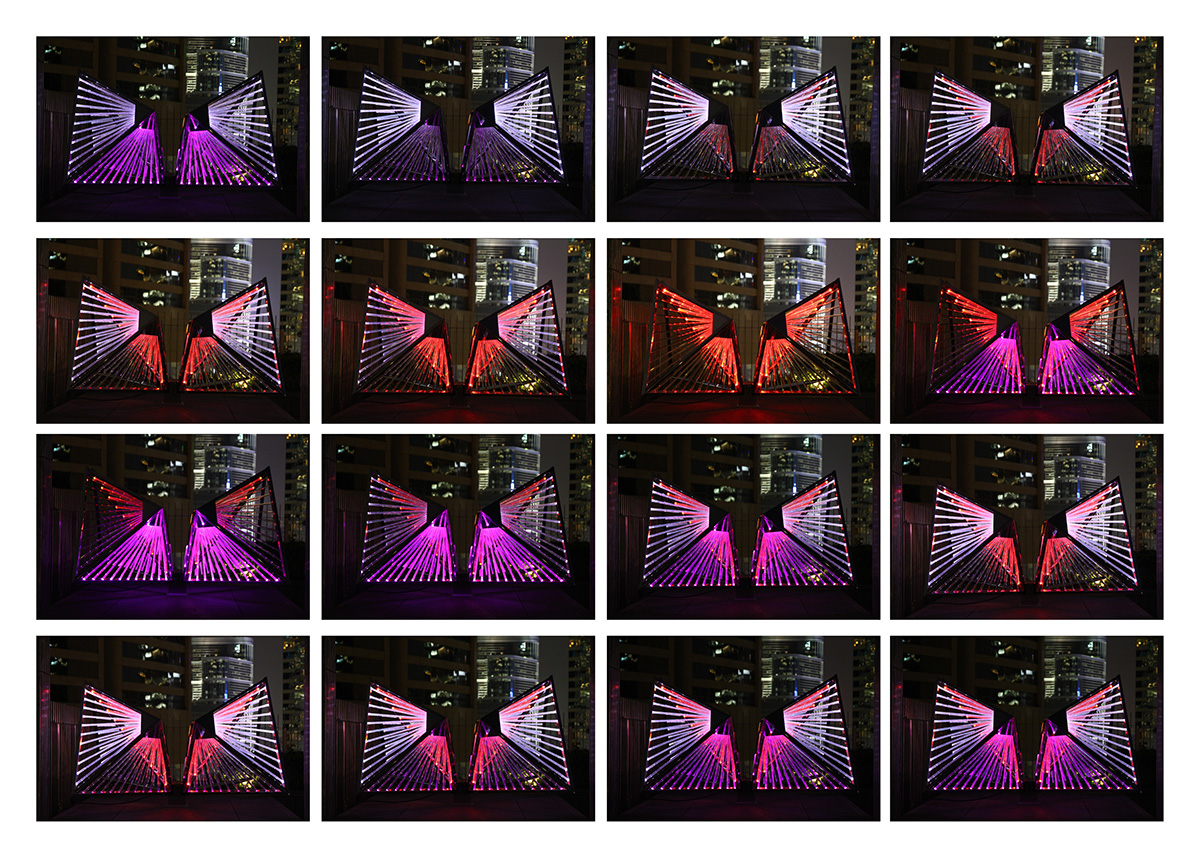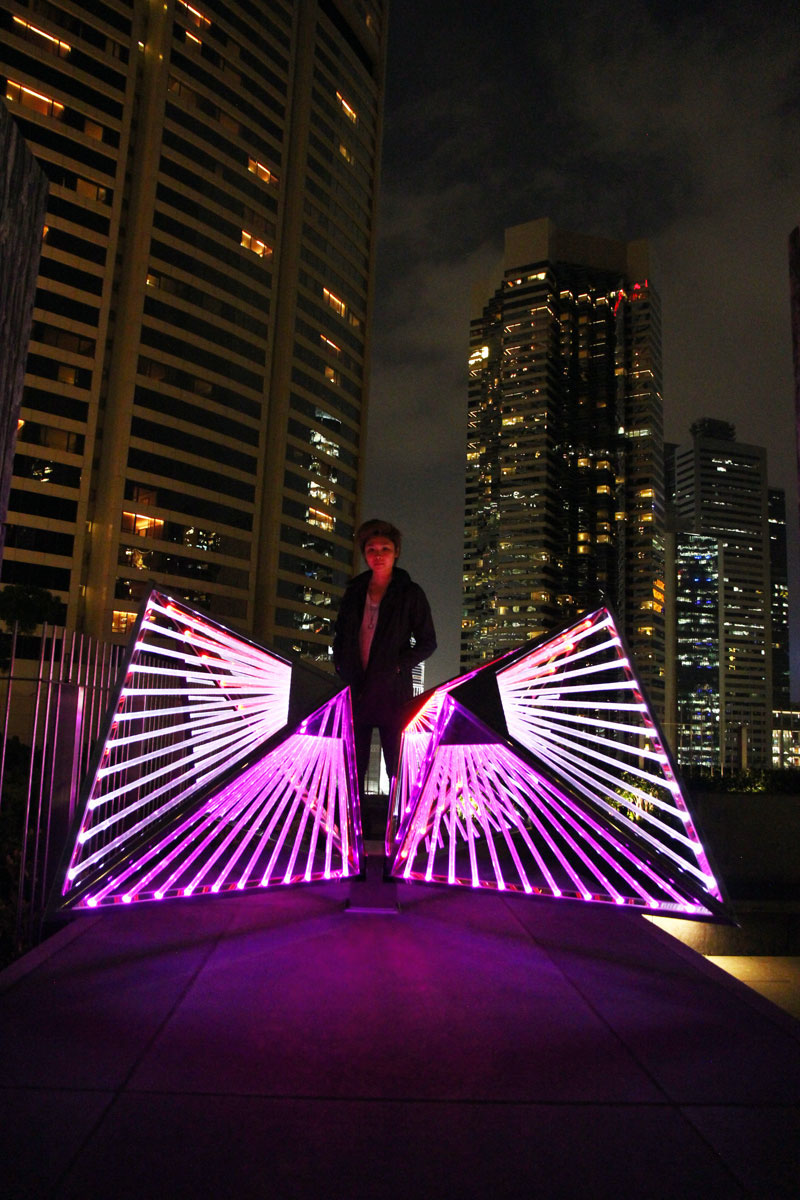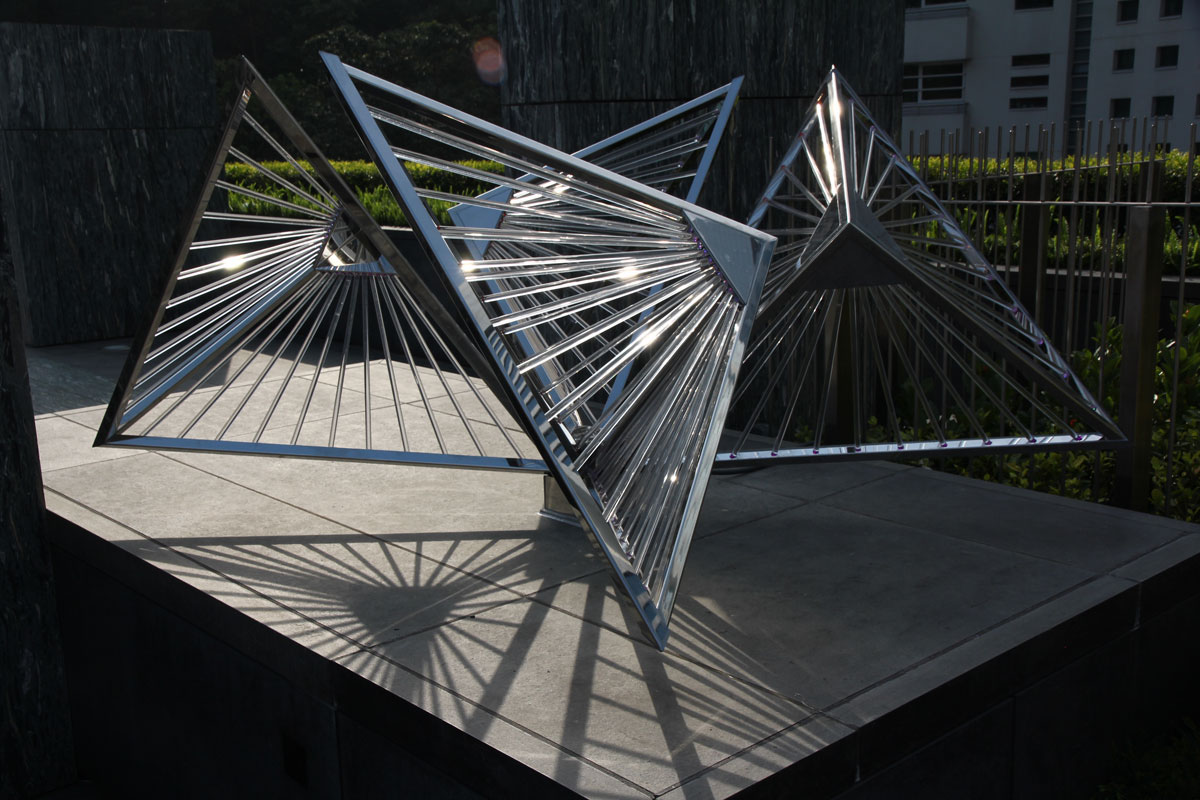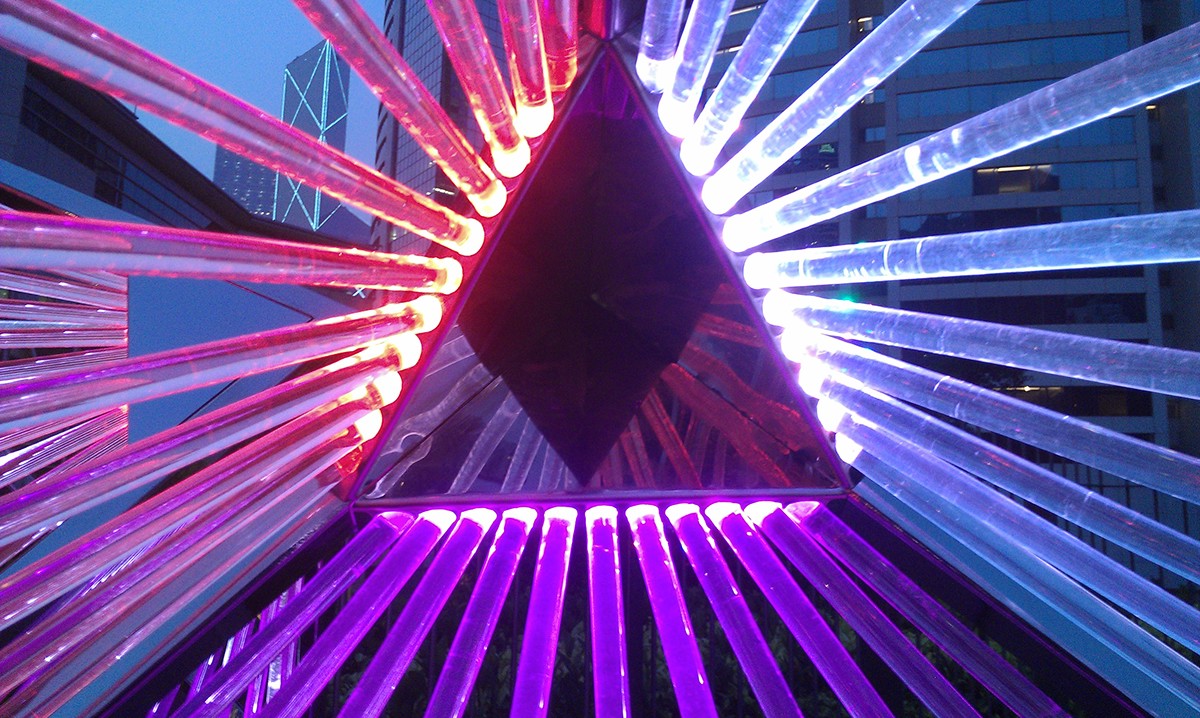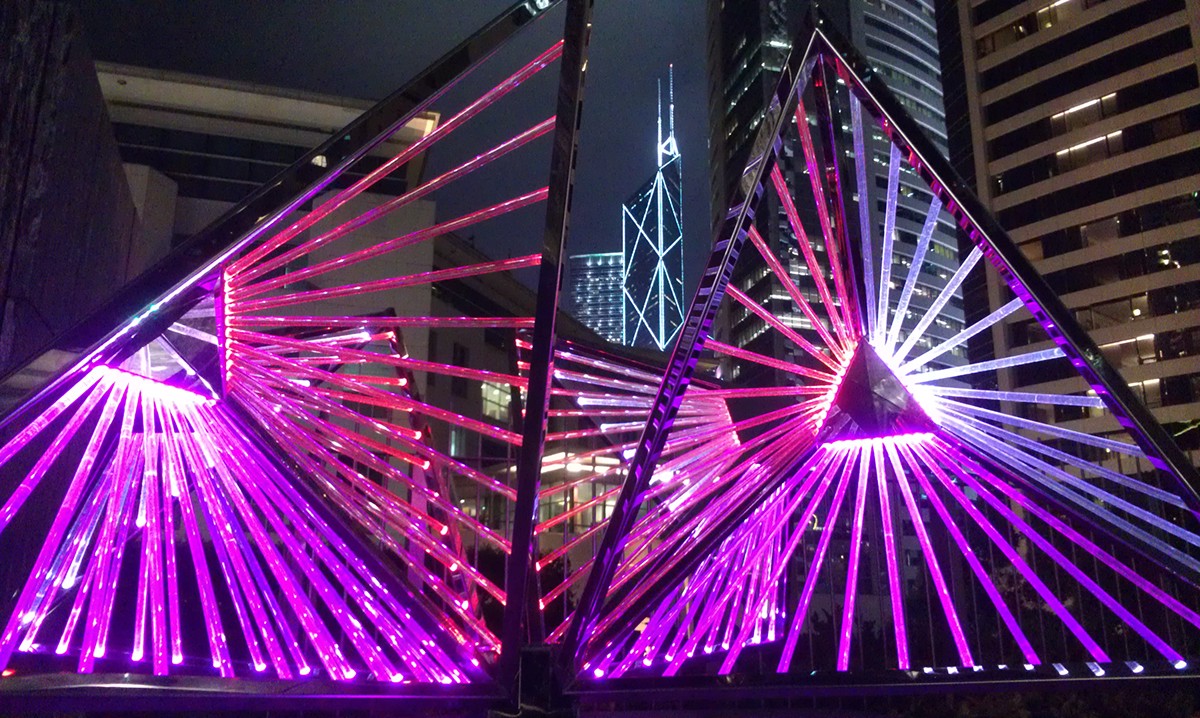
DESIGN STATEMENT: Piece: “La Technologie Culturelle d'Objet” CREDITS:
Commission: “La Technologie Culturelle d'Objet”
Designer: Wendy W Fok
Assistant: Kenneth Chi-Kan Wong
Chief Curator: Dir. Fumio Nanjo (Mori Art Museum)
Asst Curators: Amy Chow / Dominique Chan
Engineering Consultant: Wing Dik Engineering Co. Ltd (Hong Kong)
EXHIBITION:
Venue: Asia Society in Hong Kong
Exhibition: Imminent Domain
Dates: 31 January 2013 - 31 March 2013
Opening Party: 30 Jan, 2013 / Press Opening: 28 Jan, 2013
MATERIAL:
Stainless Steel Frame / Variable LED configuration
Sponsored by:
Create HK
Hong Kong Design Centre
the Hong Kong Institute of Architects
Asia Society
Copyright © atelier//studio WF
Designer: Wendy W Fok
Original: 18 November, 2012 | Updated: 24 January 2013
spatial / geometrical / mathematical / material processing
La Technologie Culturelle d'Objet was a sculptural piece commissioned by the Asia Society Hong Kong Center, invited by Chief Curator Fumio Nanjo (Director of Mori Art Musem), as part of their inaugural "Imminent Domain" exhibition with eight other Asian designers. The piece is subsequently reinstalled at the Chinese University of Hong Kong as an addition to their sculptural collection.
“L'anthropologie des techniques est une branche de l'anthropologie qui s'intéresse à l'histoire, à l'usage et aux rôles des objets techniques, y compris leur rôle symbolique. L'étude ethnologique des techniques et des objets ne se limite pas aux techniques et aux objets considérés comme « traditionnels » ou anciens mais également aux faits contemporains.”
Grounded within the concept of the “material culture” and the basis of “technology and object”, the driver of this design is interfolded through data-sourcing and data-housing. The stainless steel “objet” (installation) itself is an interpretative piece that focuses on the contemporary examination and contextualization between the theory of the technicity, ethnicity, and the milieu of André Leroi-Gourhan.
While geometrically, the piece is inspired by the "impossible objects" theory. An impossible object (also known as an impossible figure or an undecidable figure) is a type of optical illusion consisting of a two-dimensional figure which is instantly and subconsciously interpreted by the visual system as representing a projection of a three-dimensional object although it is not geometrically possible for such an object to exist (at least not in the form interpreted by the visual system).
The LED lamps held within these interactive transparent acrylic rods represent the interchangeable activators and attractors of the city and its citizens, mapped into a singular location to be viewed at the Asia Society Hong Kong Center. Each LED is embedded in an acrylic rod and is accentuated individually or clustered into “units” of stainless steel geometrical modulars. The ultimate aim is to critically analyse the contemporary state of urban cities and their landscapes, the citizens within the cityscape and a progressive understanding of their roles within each metropolis.
According to Leroi-Gourhan, in Milieu et techniques (1945), he develops a general theory of the relation between the technical (as universal tendency) and the ethnic (as specific, differentiated concretisation). The human group, according to Leroi-Gourhan, behaves as though it were a living organism, assimilating its exterior milieu via "a curtain of objects", which he also calls an "interposed membrane" and an "artificial envelope", that is, technology. The milieu of the organism is divisible into the exterior milieu (geography, climate, animals and vegetation) and the interior milieu (the shared past of the group, thus "culture", etc.). This division enables a clarification of the concept of technical tendency. A tendency, according to Leroi-Gourhan, is a movement, within the interior milieu, that gains progressive foothold in the exterior milieu.
French philosopher Gilles Deleuze frequently cites leroi-Gourhan in the two-volume collaboration and psychiatrist Félix Guattari entitled Capitalism and Schizophrenia. The hand/tool and face/vocalization couplings of Leroi-Gourhan play an important role in the development of Deleuze and Guattari's concepts of becoming and deterritorialisation.
Data-Transfer:
Interactive information gathered from different nodes within the city that is activated through media controlled LED lights are embedded within housing units in an acrylic cube (2000mm x 2000mm x 1000mm). Each LED is accentuated as clustered “units” of reflective geometrical forms, which mimics and breathes with the beat of the city.
Form/Fabrication:
The geometric formation of the LED lamps embedded within reflective modular units, represent the interchangeable activators and attractors of the city and its citizens, mapped into a singular location to be viewed at the Asia Society Hong Kong Center. The stainless steel geometric “objet” is to critically analyse the contemporary state of urban cities and their landscapes, the citizens within the cityscape, and the progressive interpretation of their roles within the city.
The different combinations of LEDs are controlled by the interfaced information from the citizens, while the technological balance of the “objet” itself is a contribution piece activated by the user. The feedback from the space and the citizens will cross-pollinate and illuminate during the evenings, while the stainless steel geometric modular combined with the surfaces blurred together formed by the myriad of LED lights is the formal housing that represent the “reflexive” nature of activated milieu.
Background:
André Leroi-Gourhan has devoted much of his work in anthropology techniques, releasing both theoretical principles (concepts of trends and developments techniques, technical environment, supportive environment of the invention and the loan), methodological frameworks (methods of analysis of the degrees of fact and the operating chain) and a general classification of technical action. These fundamental contributions to the epistemology of the disciplinary field gathered in the works of Leroi-Gourhan: The man and matter (1943/1971), “Environment and Technical” (1945/1973), Gesture and Speech, vol. 1, Technical and Language (1965), Gesture and Speech, vol. 2, memory and rhythms (1965).
展品介紹
意念:
“L'anthropologie des techniques est une branche de l'anthropologie qui s'intéresse à l'histoire, à l'usage et aux rôles des objets techniques, y compris leur rôle symbolique. L'étude ethnologique des techniques et des objets ne se limite pas aux techniques et aux objets considérés comme « traditionnels » ou anciens mais également aux faits contemporains.”
我們的設計意念來自“物質文化”,以“科技與物件”為基礎,經過數據搜尋及數據存庫程序的交錯摺疊。參展作品(裝置)可以被視爲對André Leroi-Gourhan有關技術、種族及環境理論的當代重新演繹及運用。
根據Leroi-Gourhan 的著作“Milleu et techniques”(1945年),他提出技術(為廣泛傾向)與種族(為特定、不同的具體)關係的理論。他認為人類這個群組的行爲就像生物一樣,會透過“一系列物件”吸收外界環境,他稱為“中介薄膜”和“人造封套” ,既是科技。生物的環境可分為外界環境(地理、氣候、動物和植物)與內部環境(群組的共同過去或 “文化”等),這條界線可以釐清技術傾向的概念。Leroi-Gourhan 認為傾向即是一種運動,由內部環境開始,然後逐漸踏足外界環境。
法國哲學家 Gilles Deleuze與精神病理學家 Félix Guattari 合作寫了一套兩冊的“Capitalism and Schizophrenia”,其中重複引述了 Leroi-Gourhan 的理論。Leroi-Gourhan 提出的手/工具與臉/發聲組合對兩位學者發展出“轉成”及“破除疆界”等概念起了重要作用。
數據轉移:
從城市的不同據點搜集得來的互動訊息,牽動著媒體控制的LED燈。整套LED燈管會放入丙烯酸的膠立方體內(2000 x 2000 x 1000毫米),每個LED燈以獨立或群組形式集結成不同單位的幾何形狀反光面結構。
形狀/製造:
展品的互動式透明立方體帶有裝著LED燈的反光結構,代表城市中可替換的啟動者和吸引者與居民的關係,再整體濃縮到亞洲協會香港中心的單一展示位置。本裝置旨在批判性地分析當代都市及景觀、城市景觀中的市民,以及各自對自己在城市中的角色的理解。
展品集合了不同的LED燈組合,由市民發出的訊息控制,而展品(裝置)本身的技術平衡則由使用者啟動。四周和市民的動靜會透過作品在晚上亮起來而互相交錯,它的幾何形反光面代表了受干擾的環境的“反射”本能。
背景:
André Leroi-Gourhan 一生鑽研人類學技術,學術著作範圍包括理論原則(趨勢與發展技術的概念、技術環境、發明與借物的支持環境)、方法論架構(真實度及連鎖操作的分析方法),以及技術活動的常用分類。這些理論歸納成他的多本著作:“The man and matter” (1943/1971)、“Environment and Technical” (1945/1973)、“Gesture and Speech, vol. 1, Technical and Language”(1965)、“Gesture and Speech, vol. 2, memory and rhythms” (1965)。
Commission: “La Technologie Culturelle d'Objet”
Designer: Wendy W Fok
Assistant: Kenneth Chi-Kan Wong
Chief Curator: Dir. Fumio Nanjo (Mori Art Museum)
Asst Curators: Amy Chow / Dominique Chan
Engineering Consultant: Wing Dik Engineering Co. Ltd (Hong Kong)
EXHIBITION:
Venue: Asia Society in Hong Kong
Exhibition: Imminent Domain
Dates: 31 January 2013 - 31 March 2013
Opening Party: 30 Jan, 2013 / Press Opening: 28 Jan, 2013
MATERIAL:
Stainless Steel Frame / Variable LED configuration
Sponsored by:
Create HK
Hong Kong Design Centre
the Hong Kong Institute of Architects
Asia Society
Copyright © atelier//studio WF

